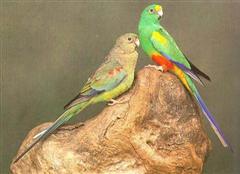Parakeet - Mulga
Mulga Parrot, Mulga, Many-Colors Parrot, Many-Colors Parakeet, Varied Parrot Scientific Name: Psephotus varius
Fri, 1st November, 2024 - 2:34 am GMT
Sponsor Ads:

Alternative Name
Mulga Parrot, Mulga, Many-Colors Parrot, Many-Colors Parakeet, Varied Parrot Scientific Name: Psephotus variusBasic Info
The average adult Mulga Parrot measures 10.8 inches (27centimeters) in length, making them a medium sized parrot. They are known for their colorful wings. Males and females can be distinguished by differences in their coloring. Males are a brilliant green overall with paler green coloring on their lower breast. Females are more of an olive green color overall with a brownish-green breast. The males have a distinct red patch on their crown and yellow foreheads. The females have a dull red patch on their crown and their foreheads are also a duller color, which is somewhat orangey-yellow. The males' thighs and abdomens are yellow; with patchy orangey-red markings Females have entirely green under-parts. Males have a dark grey bill, compared with the brownish-grey bill of the female. Both males and females have brown eyes at maturity. Immature Mulgas can be distinguished from adults by their muted colors; adult plumage is typically reached by 6 months of age.
Health
The Mulga Parrot is a hardy parrot, but it may not do well in wet, cold living conditions. Mulga Parrots have a great fondness for dust baths, and they generally like to be on the ground. For this reason, if they are kept in an outdoor aviary, they may require regular worming. In addition, their ground habits may also make them more predisposed to fungal infections. Regular cleaning of their aviaries and cages are a must. An outdoor aviary should be approximately 9x3x3 feet. These parrots really need to have enough room to fly so that they do not get overweight. If you are breeding, you should also include a nest box that is 6x6x16 inches. The entrance should be approximately 2 inches in diameter. Like most parrots, the Mulga will do well on a varied diet that may include formulated pellets, millet, as well as a healthy seed mixture. Sunflower and safflower seeds should only be fed in moderation, because these birds have a tendency to become obese. These birds also require greens such as spinach and dandelion greens. Fruits should also be given. In the wild the Mulga Parrot breeds between the months of July and December, though they may build nests at other times of the year as well, so long as it follows a good rain. They build their nests low in the hollows of trees, as well as in stumps and fallen logs. A favorite is the Eucalyptus. These parrots may also use the nests of other birds. The average clutch size is 5 eggs with an incubation period of 19 days. The Mulga Parrot babies will fledge after approximately 4 weeks, though they will often stay with their parents considerably longer, usually until the next breeding season. Sexual maturity is reached somewhere between 12 to 15 months of age. The Mulga Parrot is bred regularly in captivity. Though it is growing less common in the wild, this species is not uncommon in the pet trade. This is perhaps due to its ease of breeding in captivity. In captivity, breeding season typically begins in March. It is important that the nest box be kept warm, as the female will stop brooding early, and if they are breeding in cold areas, the babies may die. These parrots may be bred as often as twice a year. The average clutch size ranges from 5 to 7 eggs. The incubation time is the same as in the wild.Habitat
N/ABehavior
The Mulga Parrot is perhaps best known for its stunning wing colors. These shy, but beautiful birds are growing in popularity among hobbyists. The Mulga Parrot is a medium sized parrot that is relatively quiet when compared with other similar sized parrots. They are well known for the soft calls. Their call consists of a soft whistle that is repeated rapidly three to four times in a row. These birds may be easily frightened by loud noises, and for this reason may not do well in an overly loud or active household. They are reported to enjoy baths, both water and dust. These birds may be kept in groups, but males may become aggressive during breeding season. For this reason, it may be best to separate them at this time.Origin
AustraliaHistory
The Mulga Parrot can be found in a wide range within the interior of Southern Australia. Unlike some parrot species, the Mulga Parrot is not typically seen in flocks, rather they are seen individually, though they may congregate in smaller groups of family members or pairs to feed. Their name may be derived from the fact that they seem to enjoy seeds from the mulga plant (Acacia aneura).Common Foods
In the wild this parrot forages most of its food, feeding on grass seeds, plants, and other plant seeds, berries, fruits, and green vegetables.Sponsor Ads:
"Knowledge of the enemy's dispositions can only be obtained from other men. Hence the use of spies, of whom there are five classes: (1) Local spies; (2) inward spies; (3) converted spies; (4) doomed spies; (5) surviving spies." -- Sun Tzu, The Art of War
Parakeet - Mulga
Coded by: BGID® | ALL RIGHTS RESERVED Copyright © 2000-2024
Disclaimer | Privacy | Report Errors / Contact | Credits








 versus
versus  The role of its Army, Politics, and Status in the World.
The role of its Army, Politics, and Status in the World. 
 versus
versus 
 This Thread is about the North Korean Military itself - the kind of army, navy, and air force they have.
This Thread is about the North Korean Military itself - the kind of army, navy, and air force they have. 
 versus
versus  versus
versus 
 versus
versus  versus
versus